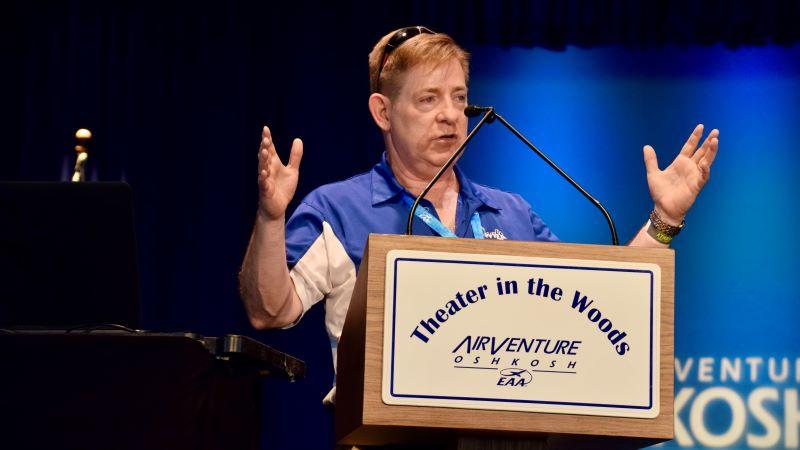
"Don’t panic" over unleaded avgas, Swift Fuels CEO Chris D’Acosta told the audience at EAA AirVenture Oshkosh.
OSHKOSH—The market will decide which of the candidate unleaded fuels being advanced to replace 100 Low Lead ultimately will make it to the pump at airports and FBOs, leaders of the Eliminate Aviation Gasoline Lead Emissions (EAGLE) initiative said July 24 at EAA AirVenture Oshkosh.
“We’re going to have a solution,” promised Pete Bunce, General Aviation Manufacturers Association president and CEO. “The marketplace is going to decide which of these fuels makes it. Can it be multiple fuels right now that comingle with eachother, [that] comingle with 100 Low Lead? Maybe, but the marketplace makes the decision.”
The EAGLE executive committee, co-chaired by Lirio Lui, executive director of the FAA Aircraft Certification Service, and Aircraft Owners and Pilots Association President and CEO Mark Baker, briefed pilots and operators attending AirVenture on the status of the initiative started in late 2021 to rid the entirety of the U.S. piston-engine aircraft fleet of leaded avgas by 2030. The group invited representatives of each of the four developers of high-octane unleaded fuel to address the audience for 10 min.
Two fuels are progressing through the Piston Aviation Fuels Initiative (PAFI), an industry-government testing program, and two through the FAA supplemental type certification (STC) process, which is proprietary between the agency and fuel developers. In September 2022, the FAA approved one of the STC candidate fuels—General Aviation Modification Inc.’s (GAMI) G100UL—for use across most of the GA piston fleet.
GAMI’s fuel is also distinguished as the only one of the four candidates that has not been vetted through the product specification process of standards organization ASTM, for which GA industry associations have expressed a preference.
“The marketplace allows people to take different pathways—we very much support the PAFI program, we support the STC process,” Bunce said. “We as manufacturers, along with the FAA and every one of these associations, [also] feel strongly about standards. Why? Because we get confidence through the standards because everyone in that ecosystem, in that value chain, can ask the right questions and get answers they can verify.”
Bunce noted that three of the four fuel developers have followed the ASTM process. “One company has elected not to go that route, which is fine,” he said. “The marketplace then decides, and the marketplace is where the winner or winners is going to predominate.”
GAMI’s head of engineering George Braly said his company started working on a high-octane unleaded avgas in December 2009. “We need to stop loving this problem and just fix it,” he said. “General Aviation Modifications Inc. has fixed the problem. We had it fixed on Sept. 1, 2022, because that’s the day the FAA issued the STC with an Approved Model List [approving] the use of G100UL without exception on every single spark-ignition piston engine found anywhere in the FAA’s type certificate database.”
Looming in the background, the FAA and GA industry associations expect the U.S. Environmental Protection Agency (EPA) will issue a final “endangerment finding” this fall that lead emissions from piston-engine aircraft that use leaded fuel endanger public health. Once that happens, the EPA will formulate a new regulation governing lead emissions from aircraft—a federal rulemaking process that will not lead to an immediate ban on 100LL, EAGLE officials assured.
“Don’t panic,” Swift Fuels CEO Chris D’Acosta exhorted the audience. “Ninety days from now, when the [EPA finding] comes out, a lot of people across the country are going to panic. Don’t invite emotional uncertainty at this time; it’s really counterproductive to everybody’s interest.”
D’Acosta said Swift Fuels has been supplying lower-octane UL94 unleaded avgas in the U.S. for eight years and has seen its fuel sales doubling every few months. As with UL94, which can be used by 60-70% of the piston fleet, Swift’s 100-octane 100R unleaded fuel is being certified through the STC as well as the ASTM processes. “94UL, 100R—it’s all coming,” he said.
Representatives of the two partnerships developing unleaded fuels through the PAFI program also addressed the audience. A fourth-generation candidate fuel from LyondellBasell and VP Racing is undergoing detonation and durability testing at the FAA Technical Center near Atlantic City, New Jersey, and has been tested on two Continental piston engines. Another fuel from Afton Chemical and Phillips 66 has been tested on a Lycoming engine. The latter fuel is using a manganese-based octane booster instead of tetra-ethyl-lead.





